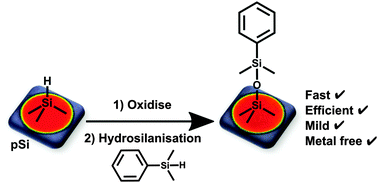Rapid, metal-free hydrosilanisation chemistry for porous silicon surface modification†
Abstract
Here, we report a novel surface modification for porous silicon (pSi). Hydroxyl-terminated pSi surfaces are modified with a hydrosilane via Si–H activation using the Lewis acid catalyst tris(pentafluorophenyl) borane. This surface reaction is fast and efficient at room temperature, and leads to a surface stabilised against hydrolytic attack in aqueous media. The resulting surface shows promise as a substrate for surface-assisted laser desorption/ionisation mass spectrometry.


 Please wait while we load your content...
Please wait while we load your content...